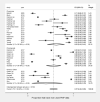Health Care Provider Utilization of Prescription Monitoring Programs: A Systematic Review and Meta-Analysis
- PMID: 33484144
- PMCID: PMC8311582
- DOI: 10.1093/pm/pnaa412
Health Care Provider Utilization of Prescription Monitoring Programs: A Systematic Review and Meta-Analysis
Abstract
Objective: To synthesize the literature on the proportion of health care providers who access and use prescription monitoring program data in their practice, as well as associated barriers to the use of such data.
Design: We performed a systematic review using a standard systematic review method with meta-analysis and qualitative meta-summary. We included full-published peer-reviewed reports of study data, as well as theses and dissertations.
Methods: We identified relevant quantitative and qualitative studies. We synthesized outcomes related to prescription monitoring program data use (i.e., ever used, frequency of use). We pooled the proportion of health care providers who had ever used prescription monitoring program data by using random effects models, and we used meta-summary methodology to identify prescription monitoring program use barriers.
Results: Fifty-three studies were included in our review, all from the United States. Of these, 46 reported on prescription monitoring program use and 32 reported on barriers. The pooled proportion of health care providers who had ever used prescription monitoring program data was 0.57 (95% confidence interval: 0.48-0.66). Common barriers to prescription monitoring program data use included time constraints and administrative burdens, low perceived value of prescription monitoring program data, and problems with prescription monitoring program system usability.
Conclusions: Our study found that health care providers underutilize prescription monitoring program data and that many barriers exist to prescription monitoring program data use.
Keywords: Opioids; Prescription Drug Monitoring Programs; Prescription Monitoring Programs; Systematic Review; Utilization.
© The Author(s) 2021. Published by Oxford University Press on behalf of the American Academy of Pain Medicine.
Figures


Similar articles
-
Physicians' Perspectives Regarding Prescription Drug Monitoring Program Use Within the Department of Veterans Affairs: a Multi-State Qualitative Study.J Gen Intern Med. 2018 Aug;33(8):1253-1259. doi: 10.1007/s11606-018-4374-1. Epub 2018 Mar 8. J Gen Intern Med. 2018. PMID: 29520747 Free PMC article.
-
Barriers to Utilization of Prescription Drug Monitoring Programs Among Prescribing Physicians and Advanced Practice Registered Nurses at Veterans Health Administration Facilities in Oregon.Pain Med. 2020 Apr 1;21(4):695-703. doi: 10.1093/pm/pnz289. Pain Med. 2020. PMID: 31722393
-
Physician attitudes and experiences with Maryland's prescription drug monitoring program (PDMP).Addiction. 2017 Feb;112(2):311-319. doi: 10.1111/add.13620. Epub 2016 Nov 3. Addiction. 2017. PMID: 27658522
-
A Systematic Review of Interventions and Programs Targeting Appropriate Prescribing of Opioids.Pain Physician. 2019 May;22(3):229-240. Pain Physician. 2019. PMID: 31151331
-
Effectiveness of Prescription Monitoring Programs in Reducing Opioid Prescribing, Dispensing, and Use Outcomes: A Systematic Review.J Pain. 2019 Dec;20(12):1383-1393. doi: 10.1016/j.jpain.2019.04.007. Epub 2019 May 3. J Pain. 2019. PMID: 31059823
Cited by
-
National Estimates and Physician-Reported Impacts of Prescription Drug Monitoring Program Use.J Gen Intern Med. 2023 Mar;38(4):881-888. doi: 10.1007/s11606-022-07793-x. Epub 2022 Oct 13. J Gen Intern Med. 2023. PMID: 36229762 Free PMC article.
-
Implementation of a Machine Learning Risk Prediction Model for Postpartum Depression in the Electronic Health Records.AMIA Jt Summits Transl Sci Proc. 2024 Oct 21;2024:1057-1066. eCollection 2024. AMIA Jt Summits Transl Sci Proc. 2024. PMID: 39444417 Free PMC article.
-
The effectiveness of prescription drug monitoring programs at reducing opioid-related harms and consequences: a systematic review.BMC Health Serv Res. 2019 Nov 1;19(1):784. doi: 10.1186/s12913-019-4642-8. BMC Health Serv Res. 2019. PMID: 31675963 Free PMC article.
-
Optimization of Prescription Drug Monitoring Program to Overcome Opioid Epidemic in West Virginia.Cureus. 2022 Feb 21;14(2):e22434. doi: 10.7759/cureus.22434. eCollection 2022 Feb. Cureus. 2022. PMID: 35371719 Free PMC article. Review.
References
-
- Canadian Centre on Substance Use and Addiction. Prescription Opioids (Canadian Drug Summary)—A Summary from the Canadian Center on Substance Use and Addiction. 2017:1–12. Available at: https://www.ccsa.ca/prescription-opioids-canadian-drug-summary (accessed April 2019).
-
- European Monitoring System for Drugs and Drug Addiction. European Drug Report Trends and Developments 2017 [Internet]. European Union Publications Office. 2017. Available at: http://www.emcdda.europa.eu/system/files/publications/4541/TDAT17001ENN.... (accessed September 2019).
-
- Whelan E, Asbridge M.. The OxyContin crisis: Problematisation and responsibilisation strategies in addiction, pain, and general medicine journals. Int J Drug Policy 2013;24(5):402–11. - PubMed
Publication types
MeSH terms
Grants and funding
LinkOut - more resources
Full Text Sources
Other Literature Sources

